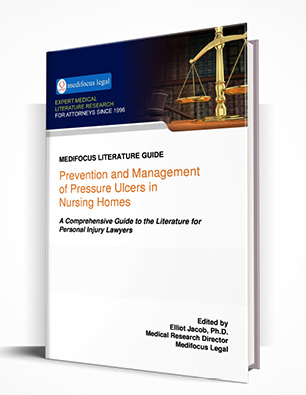Prevention and Management of Pressure Ulcers in Nursing HomesA Comprehensive Guide to the Literature for Personal Injury Lawyers
Publisher: Medifocus Legal
Publication Date: February 13, 2017
Number of Pages: 157
A Comprehensive Guide to the Literature for Personal Injury Lawyers
Publisher: Medifocus LegalPublication Date: February 13, 2017
Number of Pages: 157
Pressure ulcers are common medical conditions seen in U.S. nursing homes and are one of the important measures of the quality of care provided by staff to nursing home residents. According to the U.S. Centers for Disease Control and Prevention (CDC), the prevalence of pressure home ulcers in U.S. nursing homes is estimated to be 11%. The CDC also notes that nursing home residents who are highly immobile and those who experience recent weight loss or bladder/bowel incontinence are at higher risk for developing pressure ulcers. Because residents who are likely to develop pressure ulcers can be identified based on well-established risk factors, preventive measures can and should be implemented early. Once a pressure ulcer reaches an advanced stage, treatment is often prolonged, expensive, and causes undue pain and suffering to elderly patients.
Nursing home staff represent the front-line defense in the prevention of pressure ulcers because of their daily interactions with residents and can readily identify those patients who are at high-risk for developing pressure ulcers. Moreover, by conducting a daily skin assessment, nursing home staff can detect early signs that precede pressure ulcer formation, including persistent areas of skin redness, warm areas of skin that indicate inflammation/infection, or a break in the skin such as an abrasion, blister, or shallow wound. Neglecting these early warning signs of an impending pressure ulcer and taking immediate necessary action to prevent a pressure ulcer from forming or progressing to a more advanced stage, lays the foundation for a nursing home negligence lawsuit.
 |
- A comprehensive bibliography of 213 journal article references indexed in MEDLINE published in well respected medical and scientific journals.
- Online access to the abstracts (summaries) of the articles.
- Online access to the free full-text version of 26 articles.
- Links to full-text sources of other articles that are available for purchase directly from individual journal publishers.
- A unique "Author Directory" consisting of the names and institutional affiliations of experts who have published and have specialized knowledge about Prevention and Management of Pressure Ulcers in Nursing Homes. The "Author Directory" is a valuable resource for quickly identifying and locating experts for case reviews, opinions, and testimony.
Select examples of topics that are covered by the articles referenced in this Guidebook include:
- Wound Healing Society 2015 update on guidelines for pressure ulcers.
- Using the Care Dependency Scale for identifying patients at risk for pressure ulcers.
- Evidence-based medicine for the prevention and treatment of pressure ulcers.
- Risk assessment tools for the prevention of pressure ulcers.
- Pressure ulcer-related pain in nursing home residents with cognitive impairment.
- Consensus panel recommendations on dressings as an adjunct to pressure ulcer prevention.
- The Association for the Advancement of Wound Care (AAWC) venous and pressure ulcer guidelines.
- Cochrane Database Systematic Review of repositioning for pressure ulcer prevention in adults.
- The relationship between nutrition and pressure ulcers in hospitals and nursing homes.
- Predictive validity of the Braden Scale for Pressure Ulcer Risk in elderly residents of long-term care facilities.
- The identification of older nursing home residents vulnerable for deterioration of Stage 1 pressure ulcers.
- Clinical decision support systems to prevent and treat pressure ulcers and under-nutrition in nursing homes.
- Guidelines for seating in pressure ulcer prevention and management.
- Pressure ulcer pain: A systematic literature review and national pressure ulcer advisory panel white paper.
- The National Pressure Ulcer Long-Term Care Study on outcomes of pressure ulcer treatments in long-term care.
- The effects of combinations of repositioning and pressure-reducing devices on the incidence of pressure ulcers.
- Medico-legal aspects of pressure ulcers.
- Pressure ulcers in nursing homes: Does negligence litigation exceed the avaialable evidence?
- Epidemiology, medico-legal implications, and forensic augmentation concerning causality in pressure ulcer cases.
is available in two formats: | |
Order by Phone:To order by phone, please call: Order by Mail:To order by mail, please print and complete this Order Form | |

